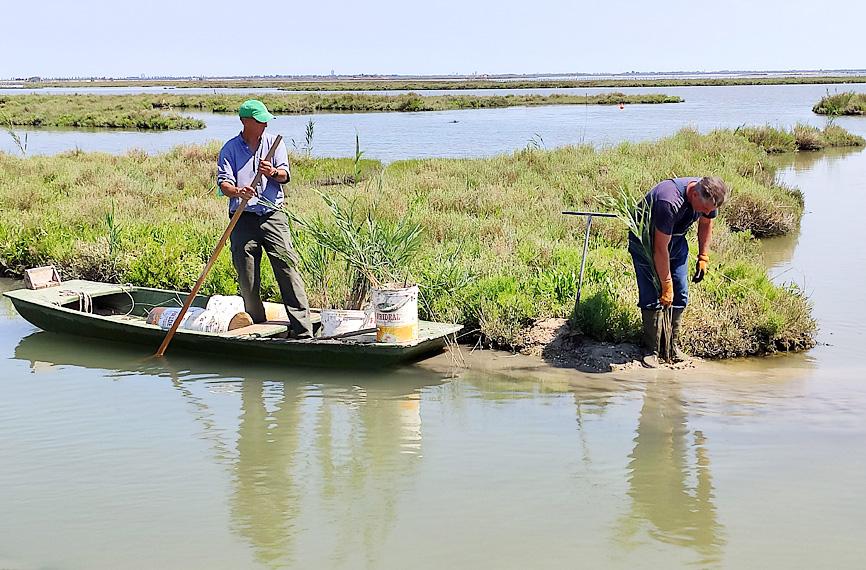Venice might be famed for Saint Mark’s Square or the Bridge of Sighs, but the Italian city has another jewel that is often overlooked: its lagoon.
Once home to a rich variety of fish and birds, mankind’s meddling has raised the water’s salt content dramatically. However, an environmental project aims to restore it to its former glory by introducing more fresh water.
“The idea is to recreate an environment that has been lost over time because rivers were diverted out of the lagoon,” said Rossella Boscolo Brusa, a researcher at the Italian Institute for Environmental Protection and Research who is leading the project.

Photo: AFP
The diversions were done to clean up swampy areas and combat malaria, Brusa said.
However, the move had an unforeseen consequence.
“It led to increasingly salty water and drop in the number of reeds — a very precious habitat for protected species, or species of commercial interest,” she said.
It is peaceful out on the lagoon — the only noise comes from the occasional tourist boat or the calls of a lapwing, sandpiper or egret.
Adriano Sfriso, a professor at Ca Foscari University of Venice’s department of environmental sciences, informatics and statistics, said that more than half, or about 17,000 hectares, of the lagoon used to be reedbeds and salt marshes.
The city’s Cannaregio district was even named after the plants — “canna” being the Italian for “reed.”
Today, only 34 hectares remain, he said.
The reeds tolerate some salinity, but in the inner part of the lagoon, where the water should be between zero and 15 on the salinity scale; it is 30, which is not far off the amount found in seawater.
Dubbed “Life Lagoon Refresh,” the project, launched in 2017, diverts a freshwater flow from the Sile River into the lagoon.
A man-made canal, operational since May, allows the flow of water to be modulated according to the project’s needs or high tides.
Barriers made of biodegradable coconut fibers contain the fresh water in the target area and help the reeds develop.
The project aims to restore about 20 hectares of reeds, Sfriso said.
Carlo Marchesi, the owner of a valliculture company, and his employee, Adriano Croitoru, meticulously uproot reeds, taking care not to disturb the birds, before punting a few kilometers away to replant the clods.
“We’re going to rebuild the lagoon as our great-grandfathers knew it, much richer in fish and birds,” 56-year-old Marchesi said.
Local fishermen and bird hunters have also been roped in to help transplant seagrasses that would speed up the return of aquatic plants.
“The lagoon is our life, our world,” said Massimo Parravicini, head of the main amateur fishermen and hunters’ association in the area.
“If we preserve it, we will be able to enjoy it as much as possible, and pass it on to our sons,” said the 58-year-old, who regularly volunteers with the project, which he describes as “fundamental to the ecosystem.”
The salinity is continuously monitored, as is the water quality, vegetation and fauna. A large net is dragged vertically through the water as per the seine fishing method. A team is tasked with tallying the species.
Some, such as the grass goby, are protected, while others, including the sea bream, mullet, flounder and branzino, are important for small-scale fishing, said Luca Scapin, a researcher at the university’s environmental sciences department.
The project, supported by the European Commission, also aims to draw birds such as the purple heron.
The results are to be shared with sites that have similar issues, from Hyeres in France, to Albufera in Spain, and the Nestos Delta and Porto Lagos in Greece.

PARLIAMENT CHAOS: Police forcibly removed Brazilian Deputy Glauber Braga after he called the legislation part of a ‘coup offensive’ and occupied the speaker’s chair Brazil’s lower house of Congress early yesterday approved a bill that could slash former Brazilian president Jair Bolsonaro’s prison sentence for plotting a coup, after efforts by a lawmaker to disrupt the proceedings sparked chaos in parliament. Bolsonaro has been serving a 27-year term since last month after his conviction for a scheme to stop Brazilian President Luiz Inacio Lula da Silva from taking office after the 2022 election. Lawmakers had been discussing a bill that would significantly reduce sentences for several crimes, including attempting a coup d’etat — opening up the prospect that Bolsonaro, 70, could have his sentence cut to

China yesterday held a low-key memorial ceremony for the 1937 Nanjing Massacre, with Chinese President Xi Jinping (習近平) not attending, despite a diplomatic crisis between Beijing and Tokyo over Taiwan. Beijing has raged at Tokyo since Japanese Prime Minister Sanae Takaichi last month said that a hypothetical Chinese attack on Taiwan could trigger a military response from Japan. China and Japan have long sparred over their painful history. China consistently reminds its people of the 1937 Nanjing Massacre, in which it says Japanese troops killed 300,000 people in what was then its capital. A post-World War II Allied tribunal put the death toll

‘UNWAVERING ALLIANCE’: The US Department of State said that China’s actions during military drills with Russia were not conducive to regional peace and stability The US on Tuesday criticized China over alleged radar deployments against Japanese military aircraft during a training exercise last week, while Tokyo and Seoul yesterday scrambled jets after Chinese and Russian military aircraft conducted joint patrols near the two countries. The incidents came after Japanese Prime Minister Sanae Takaichi triggered a dispute with Beijing last month with her remarks on how Tokyo might react to a hypothetical Chinese attack on Taiwan. “China’s actions are not conducive to regional peace and stability,” a US Department of State spokesperson said late on Tuesday, referring to the radar incident. “The US-Japan alliance is stronger and more

FALLEN: The nine soldiers who were killed while carrying out combat and engineering tasks in Russia were given the title of Hero of the Democratic People’s Republic of Korea North Korean leader Kim Jong-un attended a welcoming ceremony for an army engineering unit that had returned home after carrying out duties in Russia, North Korean state media KCNA reported on Saturday. In a speech carried by KCNA, Kim praised officers and soldiers of the 528th Regiment of Engineers of the Korean People’s Army (KPA) for “heroic” conduct and “mass heroism” in fulfilling orders issued by the ruling Workers’ Party of Korea during a 120-day overseas deployment. Video footage released by North Korea showed uniformed soldiers disembarking from an aircraft, Kim hugging a soldier seated in a wheelchair, and soldiers and officials